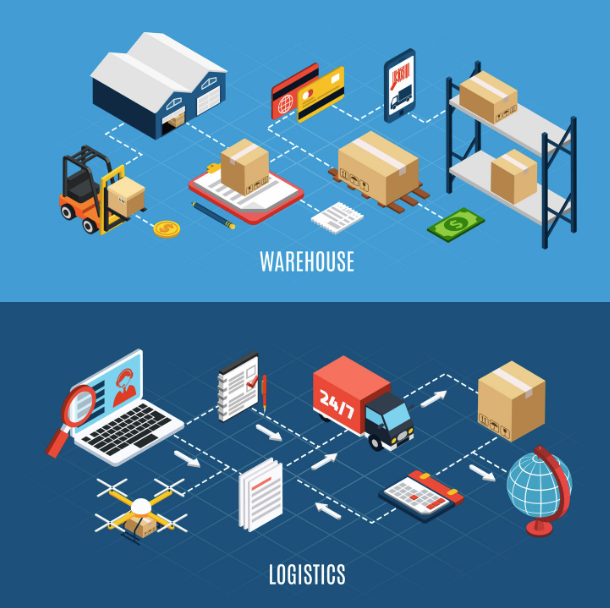In the logistics industry, documentation is consistently viewed as the "compass" or "guiding principle" for the entire operational chain. From HBL/MBL (House Bill of Lading/Master Bill of Lading), Invoice, Debit/Credit Note, Booking, and Packing List to C/O (Certificate of Origin), each type of document plays a critical role, not just in terms of forwarding but also in accounting and legal aspects.
However, with the enormous volume of documents and traditional manual processes, many businesses constantly face the risks of errors, loss, and time-consuming processing. These issues not only increase costs but also directly affect reputation and can even lead to legal disputes if not strictly controlled.
Amidst the strong wave of digitalization, the key question arises: "How can logistics documentation be managed effectively to both reduce risks and optimize operations?" Let's find the answer in the article below.
1. Common challenges in logistics documentation management

In reality, managing documentation in logistics is far from simple. Businesses must process a huge volume of documents every day, including HBL/MBL, Booking, Invoice, Debit/Credit Note, Packing List, C/O, and more. This complexity often causes significant difficulties in the operational process:
Massive and diverse document volume
Each shipment can generate dozens of different documents, demanding absolute accuracy. As the number of customers and partners increases, the volume of documentation becomes harder to control.
Manual data entry errors
Manual data entry on Excel or traditional paperwork easily leads to errors in container numbers, product codes, or waybill information. A small mistake can cause delivery delays, incur demurrage/detention costs, or lead to disputes with partners.
Scattered and difficult-to-retrieve data
Many businesses store documents across multiple channels: email, physical files, or disparate systems. When searching for a document, employees waste significant time, which reduces work efficiency.
Risk of loss and legal issues
Lost or incorrectly filed documents can result in contract disputes, customs fines, or clearance delays. This directly impacts the company's reputation and operational costs.
Lack of transparency and control
Manual management makes it difficult for businesses to track the real-time status of documents. A lack of consolidated reports diminishes the ability to make quick and accurate decisions.
These challenges show that, if logistics businesses continue to maintain manual document management methods, they will struggle to achieve optimal efficiency in the current competitive and digitalized landscape.
2. Effective logistics document management solutions

To overcome the inherent challenges, logistics businesses need to transition from manual methods to digitalized and automated document management. Some prominent solutions that businesses can adopt include:
Digitalization and centralization of document data
For effective document management, logistics enterprises must shift from manual practices to implementing digital and automation technology. Centralizing data on a single platform is the first and most crucial step. Instead of documents being scattered across emails, Excel sheets, or physical paper files, they should all be digitalized and stored in an ERP, FMS, or CRM system. This approach not only allows staff to easily look up information within seconds but also minimizes the risk of loss. Concurrently, establishing clear access rights by department provides greater transparency and data security.
Automated data entry using OCR and AI
Another outstanding solution is the application of OCR technology combined with AI to automate data entry. Instead of having employees manually enter every number or product code, the system can read and extract data directly from PDF files, booking forms, or bills of lading. With the support of AI, the system is also capable of processing data from various document templates used by different shipping lines, which increases accuracy and reduces data entry time by up to 70%. This is a significant step forward, helping businesses save human resources and limit the risk of errors.
Standardization of document review and approval processes
In parallel, businesses also need to standardize the document review and approval process. When an automated workflow is in place, documents will pass through clear steps—such as creation by staff, approval by managers, and storage—ensuring completeness and accuracy before being sent to customers or partners. This process not only shortens processing time but also minimizes legal risks that may arise in case of disputes.
Integration of the document management system with other platforms
Another key factor is the ability to integrate the document management system with other platforms. In reality, many logistics businesses operate multiple tools simultaneously, such as email, accounting systems, ERP, or CRM. If they are not connected, data will be fragmented, and employees will have to repeatedly enter the same information in multiple places. Integration helps to synchronize data in real-time, creating a "single source of truth" that all departments can monitor and utilize.
Enhanced security and legal compliance
Finally, businesses must focus on security and legal compliance in document management. Since logistics documents relate to finance, contracts, and customs, any leakage or error can lead to severe consequences. Using multi-layered encrypted cloud storage, combined with a strict access control policy, will help protect data securely. Moreover, adherence to international regulations like GDPR or ISO standards, along along with local laws, is a prerequisite for businesses to confidently expand global cooperation.
3. Long-term benefits of effective logistics document management

Cost savings and error reduction
One of the most apparent benefits of effective logistics document management is the reduction of operating costs. Instead of spending resources on manual data entry, digitalization and automation systems can process documents quickly and with high accuracy. As a result, businesses not only save their budget but also minimize the risk of errors that could lead to demurrage, customs fines, or legal disputes. This forms a crucial foundation for maintaining long-term financial stability and security.
Increased productivity and processing speed
The centralization and digitalization of documents bring about outstanding efficiency in processing speed. Instead of spending hours searching for a bill of lading or an invoice in an email, employees can retrieve it within seconds on the system. The order processing workflow is therefore significantly shortened, helping the business serve customers and partners more quickly. This improvement in productivity not only enhances internal work efficiency but also increases competitiveness within the logistics industry.
Improved customer experience
When documents are managed effectively, the services provided to customers become more accurate and transparent. On-time delivery, clear information, and the absence of documentation errors build trust and elevate the overall experience. This is a key factor that helps businesses retain customers in the long term, build sustainable relationships, and enhance market reputation.
Enhanced control and decision-making capability
Modern document management systems not only store data but also provide real-time reports. This allows managers to easily track the progress of each shipment, monitor document quality, and detect risks early. Concurrently, analyzing data from documents also helps in forecasting demand and supports more accurate strategic decision-making. This is a long-term benefit that helps businesses stay proactive in both operations and market expansion.
Creation of sustainable competitive advantage
In the context of an increasingly digitalized logistics industry, a business with effective document management will quickly assert its position. The differentiation in processing speed, accuracy, and transparency becomes a critical competitive advantage. Not only does it elevate the professional image, but the business also opens up opportunities for collaboration with international partners, setting the stage for sustainable long-term growth.
4. Sota Solutions – digital transformation provider for logistics businesses
Sota Solutions is a comprehensive digital solutions provider for businesses across various sectors, ranging from ERP, CRM to specialized management systems. Driven by the philosophy of "technology for operational efficiency," Sota not only delivers multi-industry management tools but also develops key products tailored specifically for particular specialized fields.
In the Freight Forwarder and Logistics industry, Sota Solutions has developed Sota FMS – a comprehensive transport management system. A standout feature is its integrated AI-OCR capability, which automatically reads Booking files from various shipping lines and directly synchronizes the data to the corresponding Job within the system.
Instead of manually entering a multitude of details like bill of lading numbers, container information, schedules, and booking specifics, the AI-OCR feature identifies and populates the data automatically in just a few seconds. This delivers clear benefits:
- Saves up to 70% of data entry time compared to manual methods.
- Minimizes document errors, ensuring high accuracy.
- High flexibility, supporting multiple booking formats from different shipping lines.
- Optimizes personnel costs, allowing the team to focus on high-value work like customer care and professional operations.
With Sota FMS, logistics businesses not only manage documents faster and more accurately but also enhance their reputation and competitiveness in the market through superior professionalism and speed. This is the key for Freight Forwarders to achieve breakthroughs in the era of digitalization.
5. Conclusion
Document management has always been a major challenge in the logistics industry due to its complexity, huge volume, and demand for absolute accuracy. By relying solely on manual processes, businesses inevitably face errors, document loss, and unnecessary costs. Conversely, by leveraging technology for digitalization, automation, and process standardization, businesses not only solve immediate problems but also create long-term benefits: cost savings, increased productivity, improved customer experience, and the building of a sustainable competitive advantage. In today's environment of strong digital transformation, effective document management is no longer an option—it is a vital factor for every logistics business.